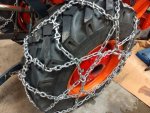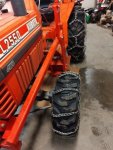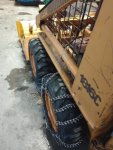torch
Well-known member
Equipment
B7100HSD, B2789, B2550, B4672, 48" cultivator, homemade FEL and Cab
That's not entirely true. While rubber won't dig into ice, it can conform to irregularities on ice. That's why turf tires do reasonably well on ice and why winter tires have sipes. The trick is to avoid spinning the tires, for the same reason why ice skates glide over ice -- the effect of velocity on the surface liquid layer.Rubber slips on ice, no matter it's shape, that means spin and sit.
The effectiveness of even studded tires diminishes as the temperature drops and the ice gets harder. While steel chains can be more effective on "warm" ice or hard-packed snow, rubber chains can actually be more effective on cold, hard ice.Steel chains scratch and dig in, that means you can go.
I'm not sure I follow your logic here. The difference between front and rear should be slight. It will cause increased scuffing and tire wear on hard dry pavement, certainly. However when the primary issue is poor traction, the difference in travel speeds front to rear is inconsequential.4 wheel drive is great, if you're in a slight turn all the time. Straight ahead, the over driven front tires will bind up the drive line. In a sharper turn, the not over driven enough front tires won't let you turn.
For reference, I live in an area that typically receives as much as 18' of snow per season. Occasional warm spells can turn the hill on my drive into a sheet of ice, but temperatures often drop to -30° and occasionally below -40°. I have tried chains, I have tried steel weights and I have tried 2wd. I find filled turfs and 4wd to be the best all-round performer.
BTW: I have found 4wd not only gets me up an icy hill, it also overcomes the "tiller effect" of the blower, making steering much more effective.





